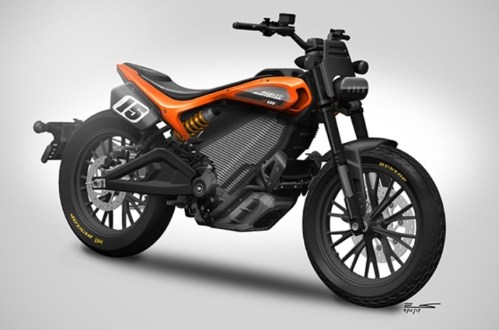
Harley-Davidson has repeatedly stressed the LiveWire, its first series-produced electric model, will spearhead a broad expansion into zero-emissions territory. It released a preview sketch that sheds light on its second battery-powered two-wheeler, a bike it cryptically refers to internally as the Mid-Power.
While the LiveWire is a relatively big cruiser, the motorcycle depicted in the sketch looks like a smaller model whose design draws inspiration from Harley’s decades-long experience in flat-track racing. There’s not much plastic fairing on it so powertrain components like the battery pack are fully exposed. Tinted LED lights and black Y-spoke wheels give it a sinister look. I don’t see analog gauges, meaning it’s likely equipped with a digital instrument cluster.
And yet, the Mid-Power looks nearly ready for production. It’s not difficult to imagine Harley bringing it to showrooms without major modifications. One thing will certainly change: The name. Mid-Power doesn’t have much of a ring to it, and it sounds like more of a code name for the model than an upcoming nameplate.
At least the designation hints at what to expect in terms of specifications. It won’t be as quick as the LiveWire, it will offer riders less horsepower, and it will come with a smaller battery pack. That doesn’t necessarily mean it will be considerably slower, because it will also be smaller and lighter. If the LiveWire is the Tesla Model S, the Mid-Power will be positioned on the same level as the Model 3. For context, Harley’s first plug-in uses a 78-horsepower electric motor, a 15.5-kilowatt-hour lithium-ion battery pack, and it offers up to 110 miles of riding range.
The Mid-Power is expected to join the Harley-Davidson range by 2022 at the latest. Pricing, like much else, remains under wraps but I expect it will cost less than the LiveWire, which starts at approximately $30,000. It will be less powerful than its bigger sibling and it will use a smaller battery pack so it will be cheaper to build. Expanding its electric lineup will allow Harley to benefit from economies of scale, and it will (hopefully) pass the savings onto riders. In the meantime, the firm is gearing up to launch a battery-powered scooter by the end of 2021.
Editors' Recommendations
- Harley-Davidson restarts Livewire sales after charging system scare
- Here’s your first look at Harley-Davidson’s new line of ebikes